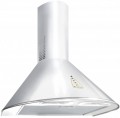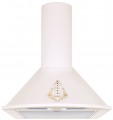—
Dome. Hood with a round or rectangular air duct; in the lower part turning into a conical or trapezoidal body. Usually, it has a discreet design with a minimum number of decorative elements. Exceptions to this rule apply to
country style, shown separately.
—
T-shaped. Outwardly, it resembles a dome hood, but instead of a conical or trapezoidal body, the air duct ends with a flat rectangular air intake. In cross-section, the system resembles the letter "T" for which it got its name.
—
Angled. In such hoods, the air intake panel is installed at an angle to the duct. This design is purely aesthetic and does not affect functionality.
—
Vertical panel. A special type of wall-mounted hood that is as close as possible to angled models, except that when not in use, the front panel is parallel to the wall and not at an angle.
—
Cylindrical. Classic cylindrical hoods.
—
Rectangular. Hoods of an even geometric shape of a solid design and do not have a division into a duct and a body (as is done in T-shaped models).
—
With glass. The main distinguishing feature of all such hoods is the presence of a glass plate in the design as an additional decorative
...element. The very appearance of the hood can be anything: dome with glass, T-shaped with glass, angled with glass, cylindrical with glass.
— Visor. Extractor hood designed for installation under a kitchen cabinet. At the same time, the air duct is hidden inside, and outside there is only a flat air intake resembling a visor (hence the name). Glass is often used in the design of the visor.
— Sliding panel. As the name implies, these hoods are equipped with a retractable air intake panel. During operation, the panel opens — thus increasing the effective suction area. The hood itself is usually built into a cabinet or table (see "Product type"). But this type can be implemented in two ways. Sliding hoods with open panel when closed have a front panel that stands out and is visible under the cabinet. Sliding hoods with hidden panel are not visible when closed, and the opening mechanism is designed in such a way that the panel extends slightly at an angle.
— Fully built-in. Hoods that are built-in in the full sense of the word: the device is almost entirely hidden in a hanging cabinet or ceiling; only the air intake panel is outside. Such an installation is known by a minimum of visible details and allows you not to worry about how the hood will fit into the kitchen interior.
— Modern (unusual design). Hoods with a hi-tech look — using polished metal, glass and a minimum of decorative elements. Most modern style hoods have a specific design that does not fit into any of the options described above; Therefore, they are separated into a separate category. However, the design of such devices may vary; there are both absolutely minimalistic and rather pretentious, original design.
— Country. Country-style hoods usually have light, soft body colours (white, beige, light grey) and structural elements decorated in wood, bronze and other similar materials. By design, such devices are usually similar to domed ones. Note that with similar performance, country hoods are noticeably more expensive than conventional style models. In addition, they are quite demanding on the environment: the whole kitchen must be made in a similar style. otherwise, it is likely that the device simply does not fit into the interior.The number of speeds at which the hood can operate.
The more speeds, the more accurately you can adjust the device's operating mode to a specific situation. At the same time, the vast majority of modern hoods have only three speeds which are enough for most occasions.
A timer that automatically turns off the hood after a predetermined time. With such a system, you do not need to wait until the completion of ventilation and turn off the device manually — just set the timer, and you can safely leave the kitchen on your own business; the hood will turn itself off at the right time.

